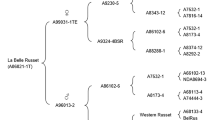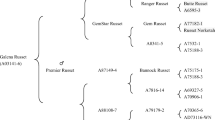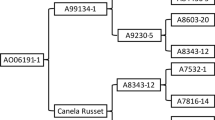Abstract
Payette Russet is a full season, russet-skinned potato cultivar notable for its cold-sweetening resistance and associated low acrylamide formation, making it ideally suited for processing into French fries and other potato products. Low asparagine and reducing sugar concentrations in Payette Russet tubers contribute to an 81 % reduction in acrylamide content in French fries relative to cultivars Ranger Russet and Russet Burbank following eight months storage at 9 °C. In three years of evaluations in the Western Regional Potato Variety Trials, average yield of Payette Russet was intermediate between Ranger Russet and Russet Burbank, but Payette Russet had the highest U.S. No. 1 yield when averaged across all eight trial locations. Acceptably low tuber glucose concentrations (<0.10 % glucose FWB) were maintained in Payette Russet following up to nine months storage at temperatures as low as 5.6 °C with consistently acceptable French fry color scores obtained (USDA value ≤2.0). Reducing sugars are also maintained uniformly throughout Payette Russet tubers, resulting in a low incidence of sugar ends and reduced mottling in French fries relative to standard processing cultivars. Long tuber dormancy also benefits long-term storage for processing. With its russet skin, Payette Russet could also be used for fresh-pack, and its assemblage of disease resistances makes it especially suitable for organic production, or for use by growers and companies seeking greater sustainability in their production. Payette Russet is resistant to foliar and tuber late blight, common scab, and has extreme resistance to PVY conferred by the presence of the Rysto resistance gene. Payette Russet also has a moderate level of resistance to Verticillium wilt, early blight, and corky ringspot. It is susceptible to Fusarium dry rot (F. sambucinum), therefore production and storage management guidelines are provided to minimize tuber infection. Payette Russet displays a low incidence of second growth and growth cracks, especially relative to Russet Burbank, and is intermediate between Ranger Russet and Russet Burbank for incidence of hollow heart/brown center. Blackspot bruise expression for Payette Russet is similar to Russet Burbank and reduced relative to Ranger Russet. Payette Russet was more susceptible to shatter bruise, internal brown spot, and tuber weight loss in storage relative to the industry standard cultivars. Payette Russet was released in 2015 by the USDA-ARS and the Agricultural Experiment Stations of Idaho, Oregon, and Washington, and is a product of the Northwest (Tri-State) Potato Variety Development Program.
Resumen
Payette Russet es una variedad de papa de ciclo completo y piel corrugada notable por su resistencia al endulzamiento por frío y por su asociación con baja formación de acrilamida, haciéndola idealmente ajustada para procesamiento en papas a la francesa y otros productos de papa. Las bajas concentraciones de asparagina y de azucares reductores en los tubérculos de Payette Russet contribuyen a una reducción del 81 % en el contenido de acrilamida en las papas a la francesa en relación con las variedades Ranger Russet y Russet Burbank después de ocho meses de almacenamiento a 9 °C. En tres años de evaluaciones en los ensayos de variedades de papa regionales del oeste, el promedio de rendimiento de Payette Russet fue intermedio entre Ranger Russet y Russet Burbank, pero Payette Russet tuvo el rendimiento más alto de U.S.1 cuando se promedió a lo largo de las ocho localidades de ensayo. Se mantuvieron aceptablemente bajas las concentraciones de glucosa (<0.10 % de glucosa FWB, peso fresco) en Payette Russet después de nueve meses de almacenamiento a temperaturas tan bajas como 5.6 °C, obteniéndose consistentemente calificaciones de color aceptable en papas a la francesa (valor USDA ≤2.0). Los azucares reductores también se mantienen uniformes a lo largo de los tubérculos de Payette Russet, resultando en una baja incidencia de extremos con azúcar y de moteado reducido en las papas a la francesa en relación con las variedades estándar para procesamiento. La dormancia prolongada del tubérculo también beneficia el almacenamiento por largos períodos para proceso. Con su piel corrugada, Payette Russet podría también usarse para empaque en fresco, y su conjunto de resistencias a enfermedades la hace apropiada específicamente para producción orgánica, o para uso por productores y compañías que buscan mayor sustentabilidad en su producción. Payette Russet es resistente al tizón tardío foliar y de tubérculo, a la roña común, y tiene resistencia extrema al PVY conferida por la presencia del gene Rysto de resistencia. Payette Russet también tiene un nivel moderado de resistencia a la marchitez por Verticillium, al tizón temprano, y a la mancha anular corchosa. Es susceptible a la pudrición seca por Fusarium (F. sambucinum), de aquí que se suministran las guías de manejo de la producción y el almacén, para minimizar la infección de tubérculo. Payette Russet exhibe baja incidencia de crecimiento secundario y de cuarteaduras por crecimiento, especialmente en relación con Russet Burbank, y es intermedia entre Ranger Russet y Russet Burbank en la incidencia de corazón hueco/centro café. La expresión de mancha negra por daño mecánico en Payette Russet es similar a la de Russet Burbank y reducida en relación a Ranger Russet. Payette Russet fue más susceptible a rompimiento por magulladuras, mancha café interna y pérdida de peso de tubérculo en almacén en relación a las variedades estándar de la industria. Payette Russet se liberó en el 2015 por el USDA_ARS y las Estaciones Agrícolas Experimentales de Idaho, Oregon y Washington, y es un producto del Programa de Desarrollo de Variedades de Papa Noroccidental (Tri-State).





Similar content being viewed by others
References
Bergers, W.W. 1980. A rapid quantitative assay for solanidine glycoalkaloids in potatoes and industrial potato protein. Potato Research 23: 105–110.
Bradford, N.M. 1976. A rapid and sensitive method for the quantitation of microgram quantities of protein using the principle of protein dye binding. Analytical Biochemistry 72: 248–254.
Bradshaw, J. 2007. Potato-breeding strategy. In Potato biology and biotechnology, advances and perspectives, ed. D. Vreugdenhil, 157–177. Oxford: Elsevier Ltd..
Brown, C.R., H. Mojtahedi, G.S. Santo, P. Hamm, J.J. Pavek, D. Corsini, S. Love, J.M. Crosslin, and P.E. Thomas. 2000. Potato germplasm resistant to corky ringspot disease. American Journal of Potato Research 77: 23–27.
Brown, C.R., H. Mojtahedi, J.M. Crosslin, S. James, B. Charlton, R.G. Novy, S.L. Love, M.I. Vales, and P. Hamm. 2009. Characterization of resistance to Corky ringspot disease in potato: a case for resistance to infection by tobacco rattle virus. American Journal of Potato Research 86: 49–55.
Corsini, D., and J.J. Pavek. 1986. Fusarium dry–rot resistant potato germplasm. American Potato Journal 63: 629–638.
Corsini, D.L., J.J. Pavek, and J.R. Davis. 1988. Verticillium wilt resistance in non-cultivated tuber-bearing Solanum species. Plant Disease 75: 148–151.
Corsini, D.L., J.J. Pavek, M.W. Martin, and C.R. Brown. 1994. Potato germplasm with combined resistance to leafroll virus and viruses X and Y. American Potato Journal 71: 377–385.
European Cultivated Potato Database, The. http://www.europotato.org/menu.php, Accessed October 25, 2016).
Haynes, K.G., B.J. Christ, D.P. Weingartner, D.S. Douches, C.A. Thill, G. Secor, W.E. Fry, and D.H. Lambert. 2002. Foliar resistance to late blight in potato clones evaluated in national trials in 1997. American Journal of Potato Research 79: 451–457.
Herman, D.J., L.O. Knowles and N.R. Knowles. 2016. Screening sweetening-resistant clones for tolerance to heat stress. Proceedings of the 99th Annual Meeting of the Potato Association of America. American Journal of Potato Research 93:132.
Johansen, R.H., B. Farnsworth, D.C. Nelson, G.A. Secor, N. Gudmestad, and P.H. Orr. 1988. Russet Norkotah: a new russet-skinned potato cultivar with wide adaptation. American Potato Journal 65: 597–604.
Knowles, N.R., D. Herman, C. Dean, G. Ellis, L. Knowles and M. Pavek. 2016. Use of growth regulators to optimize plant growth, tuber set and shape of new varieties. Proceedings of the annual Washington and Oregon potato conference, Jan. 27–28, Kennewick, WA. pp. 55–62.
Kumar, G.N.M., L.O. Knowles, and N.R. Knowles. 2015. Zebra chip disease decreases tuber (Solanum tuberosum L.) protein content by attenuating protease inhibitor levels and increasing protease activities. Planta 242: 1153–1166.
Lang, N.S., R.G. Stevens, R.E. Thornton, W.L. Pan, and S. Victory. 1999. Nutrient Management Guide: Central Washington Irrigated Potatoes. Washington State University Experiment Station Extension Bulletin EB1882.
Love, S.L., R. Novy, D.L. Corsini, J.J. Pavek, A.R. Mosley, R.E. Thornton, S.R. James, and D.C. Hane. 2002. Gem russet: a long russet potato variety with excellent fresh market and french fry processing quality. American Journal of Potato Research 79: 25–31.
Love, S.L., R.G. Novy, J.L., Whitworth, D.L. Corsini, J.J. Pavek, A.R. Mosley, M.J. Pavek, N.R. Knowles, C.R. Brown, S.R. James, D.C. Hane, and J.C. Miller. 2006. GemStar russet: a potato variety with high yield, good culinary quality, excellent fresh market appearance, and resistance to common scab. American Journal of Potato Research 83:171–180.
Milbourne, D., R.C. Meyer, A.J. Collins, L.D. Ramsay, C. Gebhardt, and R. Waugh. 1998. Isolation, characterization and mapping of simple sequence repeat loci in potato. Molecular and General Genetics 259: 233–245.
Mosley A. S., Yilma, D. Hane, S. James, K. Rykbost, C. Shock, B. Charlton, E. Eldredge, and L. Leroux. 2003. Oregon. In: K.G. Haynes (ed), National Potato Germplasm Evaluation and Enhancement Report, 2001. pp. 369–388.
Novy, R.G., S.L. Love, D.L. Corsini, J.J. Pavek, J.L. Whitworth, A.R. Mosley, S.R. James, D.C. Hane, C.C. Shock, K.A. Rykbost, C.R. Brown, R.E. Thornton, N.R. Knowles, M.J. Pavek, N. Olsen, and D.A. Inglis. 2006. Defender: a high-yielding, processing potato cultivar with foliar and tuber resistance to late blight. American Journal of Potato Research 83: 9–19.
Novy, R.G., J.L. Whitworth, J.C. Stark, B.A. Charlton, S. Yilma, N.R. Knowles, M.J. Pavek, T.L. Brandt, S. Gupta, N. Olsen, M. Thornton, C.R. Brown, D.L. Corsini, J.J. Pavek, S.R. James, D.C. Hane, H. Lozoya-Saldana, and M.I. Vales. 2012. Palisade russet: a late blight resistant potato cultivar having a low incidence of sugar ends and high specific gravity. American Journal of Potato Research 89: 89–101.
Pavek M.J. and N.R. Knowles. 2014. WSU potato cultivar yield and postharvest quality evaluations for 2013. Washington State University Special Report. 122 pages.
Pavek, M.J. and Knowles, N.R. 2016. WSU potato cultivar yield and postharvest quality evaluations for 2015. Washington State University Special Report. January, 2016, 112 pages.
Pavek, J.J., D.L. Corsini, J.G. Garner, S. Michener, W.C. Sparks, G.F. Carnahan, C.E. Stanger, A.R. Mosley, M.J. Johnson, G.E. Carter, R.E. Voss, M.W. Martin, and R.H. Johansen. 1981. Lemhi russet: a new high yielding potato variety with wide adaptation, attractive tubers, and high internal quality. American Potato Journal 58: 619–625.
Ross, F.A. 1959. Dinitrophenol method for reducing sugars. In Potato Processing, ed. W.F. Talburt and O. Smith, 469–470. Westport: AVI Publ.
Schisler, D.A., P.J. Slininger, G.E. Kleinkopf, R.J. Bothast, and R.C. Ostrowski. 2000. Biological control of Fusarium dry rot of potato tubers under commercial storage conditions. American Journal of Potato Research 77: 29–40.
Solomon-Blackburn, R.M., and H. Barker. 2001. Breeding virus resistant potatoes (Solanum tuberosum): a review of traditional and molecular approaches. Heredity 86: 17–35.
Song, Y.S., and A. Schwarzfischer. 2008. Development of STS markers for selection of extreme resistance (Ry sto ) to PVY and maternal pedigree analysis of extremely resistant cultivars. American Journal of Potato Research 85: 159–170.
United States Standards for Grades of Potatoes. 2011. United States Department of Agriculture, Agricultural Marketing Service. p 2
Valkonen, J.P.T., K. Wiegmann, J.H. Hamalainen, W. Marczewski, and K.N. Watanabe. 2008. Evidence for utility of the same PCR-based markers for selection of extreme resistance to Potato virus Y controlled by Ry sto of Solanum stoloniferum derived from different sources. The Annals of Applied Biology 152: 121–130.
Wang, Yi, P.C. Bethke, A.J. Bussan, M.T. Glynn, D.G. Holm, F.M. Navarro, R.G. Novy, J.P. Palta, M.J. Pavek, G.A. Porter, V.R. Sathuvalli, A.L. Thompson, P.J. Voglewede, J.L. Whitworth, D.I. Parish, and J.B. Endelman. 2016. Acrylamide-forming potential and agronomic properties of elite U.S. potato germplasm from the National Fry Processing Trial. Crop Science 56: 1–10.
Webb, R.E., D.R. Wilson, J.R. Shumaker, B. Graves, M.R. Henninger, J. Watts, J.A. Frank, and H.J. Murphy. 1978. Atlantic: a new potato variety with high solids, good processing quality, and resistance to pests. American Potato Journal 55: 141–145.
Zommick, D.H., L.O. Knowles, M.J. Pavek, and N.R. Knowles. 2014a. In-season heat stress compromises postharvest quality and low temperature sweetening resistance in potato (Solanum tuberosum L.). Planta 239: 1243–1263.
Zommick, D.H., L.O. Knowles, and N.R. Knowles. 2014b. Tuber respiratory profiles during low temperature sweetening (LTS) and reconditioning of LTS-resistant and susceptible potato (Solanum tuberosum L.) cultivars. Postharvest Biology and Technology 92: 128–138.
Acknowledgments
The authors thank Margaret Bain, Todd Carter, Mel Chapel, Jeanne Debons, Lorie Ewing, Mary Jo Frazier, Nora Fuller, Darren Hall, Mark Fristad, Zach Holden, Chelsey Lowder, Charlene Miller, Lura Schroeder, Steve Wheeler (deceased), and Lynn Woodell for their contributions to the development and release of Payette Russet, as well our collaborators in the Western Regional Potato Variety Trials, the National Fry Processing Trial, and the Idaho, Washington, and Oregon potato commissions. Thanks as well to Kathy Haynes, USDA-ARS, Beltsville, MD for her review of this manuscript prior to publication. We also thank our industry cooperators for their substantial contribution to this research effort, and to Dr. Rob Davidson for his evaluation of the response of Payette Russet to bacterial ring rot infection. Development of Payette Russet was partially funded by USDA/NIFA (Potato Breeding Research and SCRI [Grant #2011-51181-30629]), the Northwest Potato Research Consortium, and by contributions from the potato processing industry to the National Fry Processing Trial.
Author information
Authors and Affiliations
Corresponding author
Rights and permissions
About this article
Cite this article
Novy, R.G., Whitworth, J.L., Stark, J.C. et al. Payette Russet: a Dual-Purpose Potato Cultivar with Cold-Sweetening Resistance, Low Acrylamide Formation, and Resistance to Late Blight and Potato Virus Y. Am. J. Potato Res. 94, 38–53 (2017). https://doi.org/10.1007/s12230-016-9546-0
Published:
Issue Date:
DOI: https://doi.org/10.1007/s12230-016-9546-0




